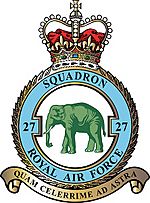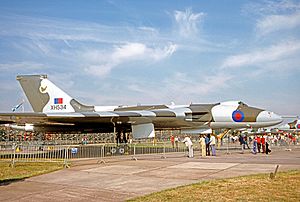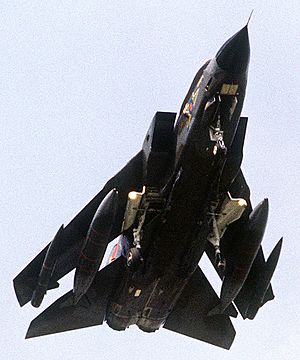No. 27 Squadron RAF facts for kids
Quick facts for kids No. 27 Squadron RAF |
|
|---|---|

Squadron badge
|
|
| Active |
|
| Country | |
| Branch | |
| Type | Flying squadron |
| Role | Helicopter heavy-lift support |
| Part of | Joint Helicopter Command |
| Home station | RAF Odiham |
| Motto(s) | Quam celerrime ad astra (Latin for 'With all speed to the Stars') |
| Aircraft | Boeing Chinook HC5,HC6a |
| Battle honours |
|
| Insignia | |
| Squadron badge heraldry | An elephant, based on an unofficial emblem first used in 1934 and commemorating the squadron's first operational aircraft (the Martinsyde G100 Elephant) and the unit's association with India. Approved by King Edward VIII in October 1936. |
No. 27 Squadron is a special flying unit of the Royal Air Force (RAF). They fly powerful Chinook helicopters from RAF Odiham in the UK. This squadron has a long and interesting history, going all the way back to World War I!
Contents
Squadron History
Early Days: World War I
No. 27 Squadron started on 5 November 1915. It was part of the Royal Flying Corps, which was the air force before the RAF. They first used planes borrowed from another squadron.
In early 1916, the squadron received its first planes, called the Martinsyde Elephant. This plane was a fighter aircraft. The squadron's badge, which shows an elephant, comes from this early plane.
The squadron moved to France in March 1916. At first, they tried to use the Elephant planes to protect other aircraft. But soon, they realized the Elephant was not good enough as a fighter.
During the Battle of the Somme, the squadron started bombing missions. They used the Martinsyde's ability to carry bombs and fly long distances. On 9 July 1916, they were told to focus mainly on bombing.
The squadron kept flying Martinsydes into 1917. They took part in big battles like the Battle of Arras and the Battle of Passchendaele. They attacked German airfields and railway lines.
Later in 1917, they started getting new planes called Airco DH.4s. These planes could carry twice as many bombs and fly faster and higher. They also had a gunner to defend against enemy planes. The squadron used both Martinsydes and DH.4s during the Battle of Cambrai.
In March 1918, the squadron moved closer to the front lines. This was because a big German attack was expected. When the attack, called Operation Michael, began on 21 March, the squadron bombed railway junctions. This helped slow down German troops.
The squadron often had to move its airfields because of the German advance. On 25 March, they were ordered to attack German troops directly from low heights. This helped stop the German breakthrough.
On 1 April 1918, the Royal Flying Corps joined with the Royal Naval Air Service. Together, they formed the Royal Air Force. This change did not stop 27 Squadron from fighting. They continued to attack German forces.
In July 1918, they began getting DH.9 bombers. However, these planes were not as good as the DH.4s. So, the squadron kept some of its DH.4s until the war ended. No. 27 Squadron was officially stopped on 22 January 1920.
Between the Wars: India Service
On 1 April 1920, No. 27 Squadron started again in India. They flew Airco DH.9A light bombers from Risalpur. Their job was to patrol the North-West Frontier.
They took part in Pink's War in 1925. This was an air bombing campaign against local tribesmen. It was the first time the RAF handled a conflict alone, without the army.
In 1928, the squadron got new planes called Westland Wapitis. They also moved to Kohat. In December 1928, two members of 27 Squadron flew an important mission. They were part of the Kabul Airlift. They flew a reconnaissance flight to check on the British Legation in Kabul during a civil war.
World War II: Fighting in the East
When Second World War started in Europe in September 1939, part of the squadron helped patrol the coast. They looked for enemy submarines and ships near Madras.
On 1 October 1939, the squadron became a training school. They trained pilots for the Indian Air Force. They used planes like the de Havilland Tiger Moth and Hawker Hart.
In January 1941, the squadron started getting Bristol Blenheim bombers. A new 27 Squadron, with Blenheims, was formed in February. They were sent to Singapore. These Blenheims were special night fighters. They were the only RAF night fighters in the Far East.
When Japan invaded Malaya on 8 December 1941, 27 Squadron attacked Japanese ships. Bad weather stopped them from finding any ships. Japanese air attacks on their airfield destroyed most of their planes.
The remaining planes moved to Singapore, then to Sumatra. On 14 February, four Blenheims attacked Japanese ships invading Sumatra. Two planes were lost. The last planes moved to Java on 15 February. At this point, the squadron almost stopped existing.
A new No. 27 Squadron was formed in India on 19 September 1942. They received Bristol Beaufighter planes. Their first mission was an attack on an airfield in Burma on 24 December 1942.
The squadron used its Beaufighters for ground attacks over Burma. They also attacked enemy ships. In April 1943, they tried out de Havilland Mosquito planes. But the Mosquitoes had problems in the hot, wet climate of Burma. So, the squadron kept using Beaufighters. They continued ground attacks and anti-shipping strikes. In April 1945, they started helping with air-jungle rescue missions.
After Japan surrendered, the squadron went to Batavia. They were involved in the Indonesian War of Independence. The squadron was stopped again on 1 February 1946.
After the War: Transport, Bombers, and Reconnaissance
On 24 November 1947, the squadron started again at RAF Oakington. This time, they were a transport unit. They flew Douglas Dakota planes. They flew regular transport routes and practiced towing gliders. They also helped in the Berlin Airlift from 1948 to 1949. The squadron was stopped on 10 November 1950.
On 15 June 1953, No. 27 Squadron reformed at RAF Scampton. They became part of the RAF's bomber force. They flew Canberra bombers. They took part in the Suez Crisis in 1956. They were stopped again on 31 December 1957.

In April 1961, the squadron reformed at RAF Scampton. They were the first squadron to get the Avro Vulcan B2 bomber. These planes were part of the UK's nuclear defense. The Vulcans carried Blue Steel missiles. Later, they carried WE.177B bombs. Their job was to support ground forces by attacking targets deep inside enemy areas.
By the end of 1971, the squadron stopped its nuclear role. In December 1973, it reformed again at RAF Scampton. They used the Vulcan B2 for Maritime Radar Reconnaissance (MRR). This meant they looked for ships and submarines using radar.
From 1973 to 1982, the squadron did 'Strategic Reconnaissance'. Their Vulcans were changed to carry special equipment. This equipment could detect and collect samples from nuclear tests. They would fly through high-altitude dust clouds or contamination. This helped scientists study nuclear weapons. The squadron was stopped again at Scampton in 1982.
The squadron reformed once more at RAF Marham in 1983. They flew twelve Tornado GR1 aircraft. They also carried eighteen WE.177 nuclear bombs. Their role was to fly low and attack targets to support ground forces. The Tornado could carry two nuclear weapons. The squadron was stopped in September 1993. Its planes and people moved to RAF Lossiemouth and became part of No. 12 Squadron.
Modern Era: Helicopters and Chinook Operations
The No. 27 Squadron name then moved to RAF Odiham. It became No. 27 (Reserve) Squadron. This unit trained pilots to fly Chinook and Puma helicopters. In January 1998, it became a full squadron again, flying only Chinooks.
In 2002, the squadron's Chinooks helped in Afghanistan. They transported Royal Marines for Operation Jacana.
The squadron also helped transport troops during the 2003 invasion of Iraq. They were based at Basra and supported Operation Telic. In July 2006, three Chinook helicopters from No. 27 Squadron went to Cyprus. They helped evacuate British citizens from Lebanon. They also deployed to Afghanistan for Operation Herrick in 2011.
In March 2020, the squadron received a special honor. They were allowed to display a battle honour on their squadron standard. This recognized their important role in the War in Afghanistan from 2001 to 2014.
Aircraft Flown by the Squadron
| Dates | Aircraft | Variant | Notes |
|---|---|---|---|
| 1915 | Various aircraft inherited from No. 24 Squadron RFC | ||
| 1916–1917 | Martynside G.100 and 102 | Single-engined biplane fighter bomber | |
| 1917–1918 | Airco DH.4 | Single-engined biplane day bomber | |
| 1918–1919 | de Havilland DH.9 | Single-engined biplane bomber | |
| 1930–1940 | Westland Wapiti | Single-engined general purpose biplane | |
| 1939–1940 | de Havilland Tiger Moth | Single-engined biplane trainer | |
| 1939–1940 | Hawker Hart | Single-engined biplane light bomber | |
| 1940–1942 | Bristol Blenheim | IF | Twin-engined light bomber |
| 1942–1944 | Bristol Beaufighter | VIF | Twin-engined ground attack |
| 1943
1943–1944 |
de Havilland Mosquito | II
VI |
Twin-engined light bomber |
| 1943–1946 | Bristol Beaufighter | X | Twin-engined ground attack |
| 1947–1950 | Douglas Dakota | Twin-engined transport | |
| 1953–1957 | English Electric Canberra | B2 | Twin-engined light bomber |
| 1961–1972
1973–1983 |
Avro Vulcan | B2
B2(MRR) |
Four-engined V-Bomber |
| 1983–1993 | Panavia Tornado | GR1 | Twin-engined ground attack/bomber |
| 1993–present | Boeing Chinook | HC2,2A,3,4,4A,5,6A | Twin-rotor transport helicopter |
See Also
- List of Royal Air Force aircraft squadrons




